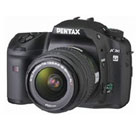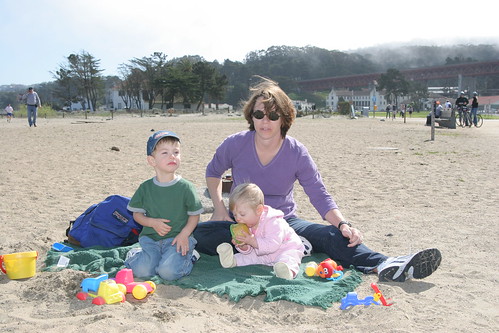
March 27, 2008
Having trouble viewing this newsletter? Read the latest issue online at
/Digital_SLR_Guide_News-03-2008.html
If someone you know has forwarded you this newsletter and you've enjoyed it, subscribe now to receive the next issue when it's published.
DSLR News - March 2008If anyone knows of a good treatment for finger wear due to excessive typing, please let me know.There seems to be no end to the new cameras piling up for release in April and May, and I've been busily updating pages across the Digital SLR Guide to keep up with all of the changes. New digital SLR guides are in the works and I'll be posting those just as fast as I can (hence the need for the finger treatment). The first one in the queue is actually a bit of a surprise, since the original press releases for the camera had it slated for release some time in May. Well, the good news for all of you Pentax enthusiasts out there is that the massive megapixel weatherproofed K20D is now available for consumer consumption. For those who aren't aware, the K20D has the highest megapixel count of any other consumer-level digital SLR camera currently available. Clocking in at a substantial 14.6 megapixels (4 million more pixels than a standard 10 megapixel DSLR), this is a great camera for anyone who wants to make very large prints. In addition to that high megapixel count, the Pentax K20D also includes a dust control system, built-in image stabilization and a live view LCD (the only one available on a Pentax digital SLR). If this sounds like the right digital SLR for you (or you've known for a long time that it's THE ONE) take a look at my eBay auction for this camera. I'm selling off the Pentax K20D that I used so that I could write a guide for it, and you get a brand new camera at a reduced cost since I've run it through its paces a bit. If you're not quite ready to drop over $1,000 on a digital SLR camera, I'm also selling a Lowepro all-weather camera bag that's in really great shape (starting bid price of $100). There's more information about these items up for sale in the recently added Digital SLR Marketplace section of this newsletter. Special Note: The site is currently experiencing some technical difficulties, especially all of the contact forms. I'm working to get the problem resolved and the forms should be up and running again soon. |
In This Issue
Latest SLR Guides
Canon 40D
Olympus E-510
Nikon D80
Canon Rebel xTi
Nikon D40
Digital SLR Terms
Megapixels
Anti-Shake
ISO / Image Noise
Sensor Dust
Crop Factor
RAW vs. JPG
Continuous Photos
Autofocus Points
Aspect Ratio
Lens Terms
Focal Length
Prime vs. Zoom
Maximum Aperture
First vs. Third Party
SLR Lens Features
Canon Lens Glossary
Nikon Lens Glossary
|
Digital SLR Lessons
- Learn digital SLR camera jargon
- Master the controls of your digital SLR
- Dramatically improve the photos you take
- NEW! Download all 5 lessons to read on the go
Common Problems
For more digital SLR camera techniques and common problems, browse through the back issues of this newsletter.This month's common problem is: my portraits outside are too dark.
If you've ever taken portraits of friends and family in direct sunlight, you've probably wound up with a photo that looks something like this:
The camera has done a great job of exposing the background, but the main subjects of the photo are WAY too dark.
Let's take a quick look at why this is happening, which will help present us with a solution to the problem.
Full sunlight creates a lot of contrast in your digital images: this means that there's a lot of range between the bright spots in the photo (the highlights) and the dark areas (the shadows).
In an artificially extreme case of contrast, your highlights would all appear as pure white, and your shadows would turn out pure black.
Most of the time, the contrast in your daylight photos won't be this severe, but really dark shadows (especially on the face of your primary subject) can reduce the impact of a nice daytime portrait.
One solution is to have your subjects stand so that the sunlight is falling on their faces, but this creates a problem of a different kind: everyone gets that squinty look because they're looking right into the sun.
But if your subjects have their backs to the sun, then the entire face is cast in shadow. While you certainly can use spot metering to lighten the shadows, this will make the rest of the background way too bright (over exposed).
So we need to do two things:
- Ensure that the background is not over exposed
- Add just a touch of light to the shadows to brighten them
The solution: pop up your camera's flash.
Even though it's broad daylight, the light emitted by the flash will add some light to the shadows, while keeping the exposure of the background intact.
Voila! An outdoor portrait where the subject is nice and bright and no one looks like they're squinting at an eye chart from across the room.
What Do You Need?
This month I'll be answering the question: Do you need dust control?Digital sensor dust only became a problem with the release of the first digital SLR camera. The reason is quite simple: since you can't take the lens off a compact digital camera, you'll never expose the sensor to dust.
The minute photographers had access to digital cameras with interchangeable lenses, the delicate sensor responsible for capturing photos became a dust magnet.
So you might be thinking "Dust? Really? What's the big deal here?"
After all, a particle of dust should not really cause your digital SLR camera to internally combust. While dust is not responsible for any digital SLR fires - that I've heard of - you can see those tiny particles of dust when you review your photos later on your computer.
That microscopic dust particle that does so little harm when floating around in the air reproduces in your digital photos as a dark smudge.
Dust spots are most apparent when you're taking photos where there's a lot of uniform color: the most common place to see dust is in landscape photos where there's plenty of blue sky.
All this would not matter very much if you could just grab a handi-wipe from the cupboard and scrub your sensor clean. Unfortunately, it's not that easy.
Digital SLR sensors are quite delicate, and if you get overzealous with your cleaning efforts you can permanently scratch or otherwise damage the sensor. You'll no longer have a camera but instead a rather expensive paperweight.
This is why the first option for cleaning your sensor makes sense to some: find a photography store where a professional will clean the sensor for you.
While this is the path of least resistance, it's also going to cost you some money to have it done. On the plus side, if you're careful about how you change lenses - or if you rarely change lenses at all - then your trips to the sensor cleaning store will be few and far between.
The second option is for more ambitious folks who don't want to pay someone else for something they feel they can accomplish on their own. For you, there's the sensor swab.
This special cleaning device is designed to remove the dust particles from a digital sensor without damaging it in any way.
When getting started you can perform this cleaning at home in a relatively dust-free environment, but once you become more adept at it you can even clean your sensor in the parking lot (although this practice is NOT recommended).
You might have guessed the third option by now: buy a digital SLR camera with a dust control system.
Olympus was the first to pioneer a dust control system which they called a SuperSonic Wave Filter (or SSWF for short). Now, many other manufacturers like Canon, Nikon, Pentax and Sony are including dust control as part of the feature set of their new SLRs.
A dust control system does several things:
- First, it uses magnetic fields to repel any dust particles that are trying to land on the sensor
- Second, the sensor shakes itself (like a dog after a bath) to clear off dust that made it past the magnetic field
- The dust particles shaken loose land on an adhesive strip so they can't get back to the sensor
Some cameras also add an extra element: you can use software to identify the locations of dust particles in your photos (when you check them on the computer) and load this data back into the camera. Once the camera knows where the dust is located, it will remove it automatically for you so you never see it again.
Cameras and Accessories
Curious about what's coming out this year? Read about all the new digital SLR cameras of 2008.Latest Olympus Digital SLR

Not so - the flurry of new digital SLR cameras continues, and the latest from Olympus is the E-420.
The defining characteristic of this camera is its SIZE and WEIGHT: measuring a mere 5.1 x 3.6 x 2.1 in. (129.5 x 91.4 x 53.3 mm) and weighing in at 13.4oz. (380g) the E-420 is one of the smallest and lightest digital SLRs you can buy.
When you pair this with a new 25mm "pancake" lens, you'll find that the E-420 doesn't require an enormous camera bag to tote around.
Despite its small size, the E-420 will include plenty of features: dust control, a live view LCD, expanded dynamic range and a face-detection autofocus system - a feature that's quite common on compact cameras but is just making the move to digital SLRs.
Look for the E-420 in May, when it will retail with a standard kit lens for about $600.
Digital SLR Marketplace
Welcome to the marketplace!Each and every month, I'll be auctioning off some digital SLR camera gear on eBay. Some of it will be like new (and used only for the purposes of a review) while others will be used - stuff that I've collected over time and don't have a use for anymore.
The bottom line? You get the opportunity to land some very good deals on camera gear that's been treated like fine china.
Here's what's available this month:
Pentax K20D With 18-55mm f/3.5-5.6 Lens

It's compatible with every Pentax lens ever made (some may require an adaptor) and the best part: its built-in image stabilization will work, even with older Pentax lenses.
The camera includes a slew of features including: dust control, a live view LCD, 3 frame per second continuous capture mode and 21 frame per second burst mode, 11 autofocus points, multiple exposures, interval timer, custom color controls and more.
Having used the camera steadily for the past two weeks I can say this about it: it's a great choice for anyone with old Pentax film SLR lenses who wants to upgrade to the best camera Pentax currently offers. While you do need to have some experience with SLR cameras to leverage the full benefit of this camera, it provides a lot of features that you can grow into.
For new camera buyers, the Pentax K20D is ideally suited for portrait photography. Its controls, feature set and the clarity of the images it captures make it a superb option for those who enjoy capturing faces, and want to be able to make large-scale prints of the final images.
- Retail Price: $1,380
- Starting Bid Price: $1,200
Bid on the Pentax K20D with 18-55mm Lens
Lowepro All Weather Camera Bag

The bag measures a substantial 16.9 x 12.6 x 10 inches (width x depth x height) and includes a main central compartment that can be configured to fit all of your equipment.
In addition, the bag has two detachable side pockets and a small removable pack for film or memory cards.
The Magnum AW is made of water-resistant ballistic nylon and can be carried comfortably by either the padded leather handle or the wide padded shoulder strap.
A weather cover pulls out from a rear zipper and can completely cover the bag in wet or dusty environments.
- Retail Price: $180
- Starting Bid Price: $100
Links
The following collection of links will help to keep you posted about what's new at the Guide and in the world of digital SLR cameras.Recent Updates to the Digital SLR Guide
Other Photography Sites
- Betterphoto.com - a wealth of photography learning opportunities
- Photojojo - a great site with tons of photography do-it-yourself (DIY) projects
- Flickr - THE social media site for photographers
- Strobist - everything you ever wanted to know about lighting with external flash
- Photo.net - lots of learning resources and plenty of examples of exceptional photography
In Conclusion
That does it for this month's issue of the digital SLR newsletter.I'll soon be posting my complete guide to the Pentax K20D for those who would like to find out more about what this high megapixel camera can do. Look for that in the next couple of weeks.
Coming soon, I'll also be getting my hands on the new Nikon D60 and the Canon Rebel XSi - look for those guides to be posted in April and May.
And for all you folks out there who already have a digital SLR camera in hand...happy picture taking!
--Chris Roberts, Your Digital SLR Guide

